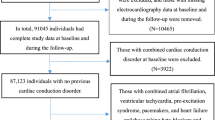Abstract
Atrial fibrillation (AF) is often associated, more or less indirectly, with an inflammatory acute or chronic process. So it is probable that the inflammation could contribute to the genesis and the perpetuation of this dysrhythmia. Phlogistic test indexes in patients (pts) with AF will be positive and have prognostic significance in patients treated with electrical cardioversion with restoration of a sinus rhythm. We evaluated 106 pts affected by AF of recent onset without known cardiovascular disease. We measured the plasma concentration of C-reactive protein (CRP) through a high sensibility method, in addition to routine blood samples. We perfomed an ECG 1 week and a Holter ECG monitoring 1 and 6 months after the electrical cardioversion. The CRP values were high (5.8 ± 10.7 U/L), with values above the normal range in 60 pts. After electrical cardioversion, we obtained restoration of sinus rhythm in all the patients. One week after cardioversion, 85 pts (80%) were in sinus rhythm, while after 6 months 60 pts (56%) maintained a sinus rhythm. In total 46 (43%) patients had a recurrence of atrial fibrillation within 6 months, and 41 of these 46 patients (89%) had elevated values of CRP (P < 0.001 with respect to the patients who maintained a sinus rhythm). 18/21 patients (86%) with an AF relapse in the first week and 23/25 patients (92%) with AF recurrences at 6 months later had elevated values of CRP. The patients with AF may have elevated values of CRP, and the assessment of this increase may be predictive of early relapses of AF after electrical cardioversion.
Similar content being viewed by others
References
Aviles RJ, Martin DO et al (2003) Inflammation as a risk factor for atrial fibrillation. Circulation 108:3006–3010
Loricchio ML, Cianfrocca C, Pasceri V et al (2007) Relation of C-reactive protein to long-term risk of recurrence of atrial fibrillation after electrical cardioversion. Am J Cardiol 99:1421–1424
Wazni O, Martin DO, Marrouche NF et al (2005) C reactive protein concentration and recurrence of atrial fibrillation after electrical cardioversion. Heart 91:1303–1305
Malouf JF, Kanagala R, Al Atawi F et al (2005) High sensitivity C-reactive protein. A novel predictor for recurrence of atrial fibrillation after successful cardioversion. J Am Coll Cardiol 46:1284–1287
Watanabe E, Arakawa T, Uchiyama T, Kodama I, Hishida H (2006) High-sensitivity C-reactive protein is predictive of successful cardioversion for atrial fibrillation and maintenance of sinus rhythm after conversion. Int J Cardiol 108(3):346–353
Chung MK, Martin DO et al (2001) C-reactive protein elevation in patients with atrial arrhythmias inflammatory mechanisms and persistence of atrial fibrillation. Circulation 104:2886–2891
Dahlin J, Svendsen P, Gadsboll N (2003) Poor maintenance of sinus rhythm after electrical cardioversion of patients with atrial fibrillation or flutter: a 5-year follow-up of 268 consecutive patients. Scand Cardiovasc J 37:324–328
Conway DSG, Buggins P, Hughes E, Lip GYH (2004) Relationship of interleukin-6 and C-reactive protein to the prothrombotic state in chronic atrial fibrillation. J Am Coll Cardiol 43:2075–2082
Hatzinikolaou-Kotsakou E, Tziakas D, Hotidis D et al (2006) Relation of C-reactive protein to the first onset and the recurrence rate in lone atrial fibrillation. Am J Cardiol 97:659–661
Cosgrave J, Foley JB, Kelly R et al (2005) Perioperative serum inflammatory response and the development of atrial fibrillation after coronary artery bypass surgery. Heart 91:1475–1476
Bruins P, Velthuis H, Yazdanbakhsh AP et al (1997) Activation of the complement system during and after cardiopulmonary bypass surgery: postsurgery activation involves C-reactive protein and is associated with postoperative arrhythmia. Circulation 96:3542–3548
Frustaci A, Chimenti C, Bellocci F, Morgante E, Russo MA, Maseri A (1997) Histological substrate of atrial biopsies in patients with lone atrial fibrillation. Circulation 96:1180–1184
Suleiman M, Khatib R, Agmon Y et al (2006) Early inflammation and risk of long-term development of heart failure and mortality in survivors of acute myocardial infarction predictive role of C-reactive protein. J Am Coll Cardiol 47:962–968
Boos CJ, Lip GY (2006) Prevention of atrial fibrillation by angiotensin-converting enzyme inhibitors and angiotensin II receptor blockers. J Am Coll Cardiol 47(4):889–890
Aksnes T, Flaa A, Strand A, Kjeldsen SA (2007) Prevention of new-onset atrial fibrillation and its predictors with angiotensin II-receptor blockers in the treatment of hypertension and heart failure. J Hypertens 25:15–23
Lefer DJ (2002) Statins as potent anti-inflammatory drugs. Circulation 106:2041–2042
Riesen WF, Engler H, Risch M, Korte W, Noseda G (2002) Short-term effects of atorvastatin on C-reactive protein. Eur Heart J 23:753–830
Siu CW, Lau CP, Tse HF (2003) Prevention of atrial fibrillation recurrence by statin therapy in patients with lone atrial fibrillation after successful cardioversion. Am J Cardiol 92:1343–1345
Fauchier L, Pierre B, de Labriolle A et al (2008) Antiarrhythmic effect of statin therapy and atrial fibrillation a meta-analysis of randomized controlled trials. J Am Coll Cardiol 51:828–835
Patti G, Chello M, Caldura D et al (2006) Randomized trial of atorvastatin for reduction of postoperative atrial fibrillation in patients undergoing cardiac surgery. Circulation 114:1455–1461
Mozaffarian D, Psaty BM, Rimm EB et al (2004) Fish intake and risk of incident atrial fibrillation. Circulation 110:368–373
Calò L, Bianconi L, Colivicchi F et al (2005) N-3 fatty acids for the prevention of atrial fibrillation after coronary artery bypass surgery: a randomized, controlled trial. J Am Coll Cardiol 17(45):1723–1728
Dernellis J, Panaretou M (2004) Relationship between C-reactive protein concentrations during glucocorticoid therapy and recurrent atrial fibrillation. Eur Heart J 25:1100–1107
Conflict of interest statement
The authors declare that they have no conflict of interest related tot the publication of this manuscript.
Author information
Authors and Affiliations
Corresponding author
Rights and permissions
About this article
Cite this article
Vizzardi, E., Nodari, S., Zanini, G. et al. High sensitivity C-reactive protein: a predictor for recurrence of atrial fibrillation after successful cardioversion. Intern Emerg Med 4, 309–313 (2009). https://doi.org/10.1007/s11739-009-0235-6
Received:
Accepted:
Published:
Issue Date:
DOI: https://doi.org/10.1007/s11739-009-0235-6




